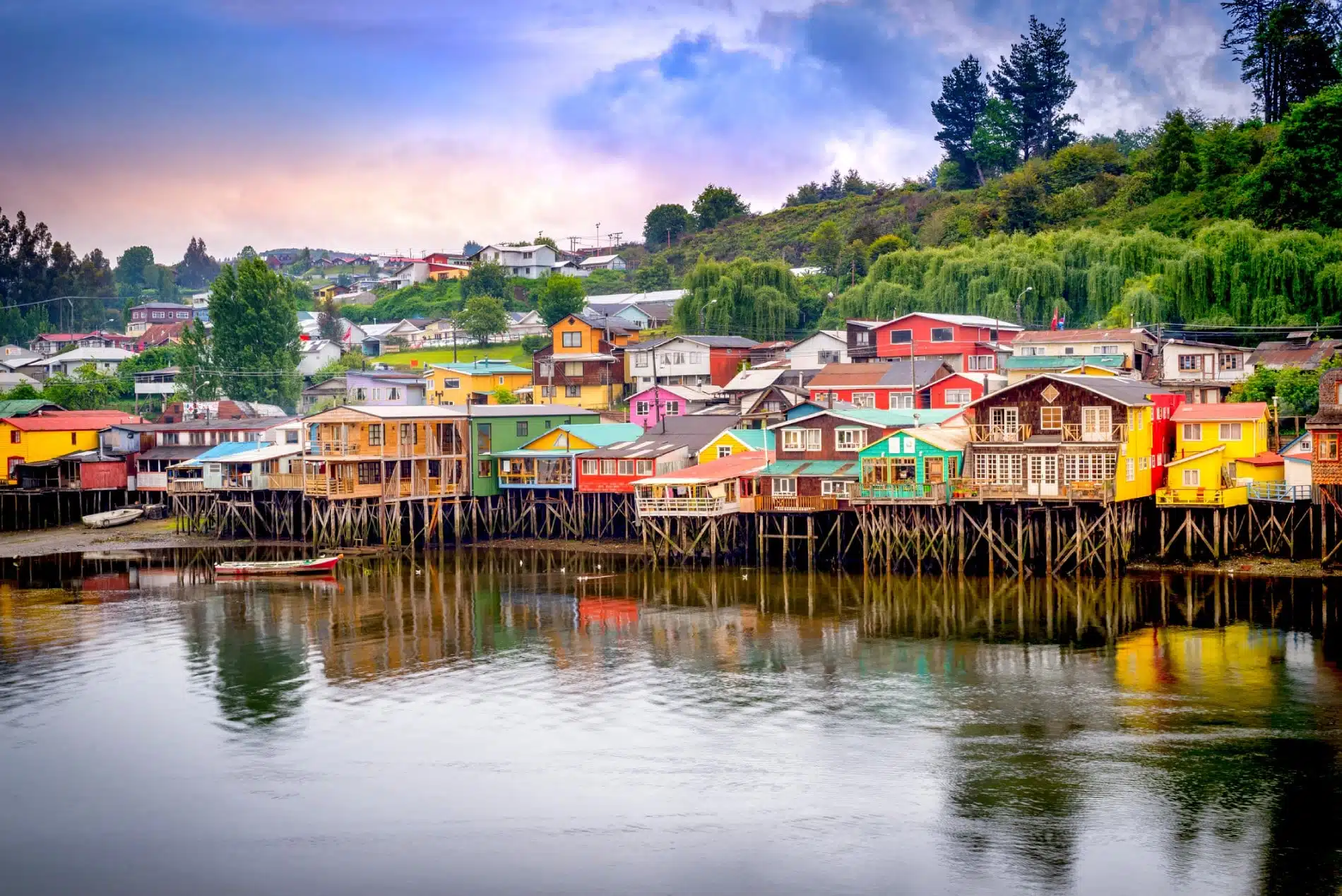



Chiloé Island, the main island in the archipelago of the same name, is in southern Chile. It’s home to pastoral landscapes and known for its iconic wooden churches built by Jesuit missionaries in the 17th and 18th centuries, such as the Church of Chonchi. The northwest coast, where blue whales gather, also has the 3 islets Islotes de Puñihuil, Natural Heritage Site, a Magellanic and Humboldt penguin breeding ground.
Summer (December to February): The best time to visit Chiloé is during the summer months when the weather is mild, with temperatures ranging from 15°C to 20°C (59°F to 68°F). It’s perfect for exploring the island’s unique landscapes and cultural sites.
Spring (September to November): Spring also offers pleasant weather and fewer crowds, making it a good time to visit if you prefer a quieter experience. You’ll also witness the blooming of flowers and lush greenery.
Autumn (March to May): This season is ideal for those who enjoy the fall foliage and cooler temperatures, although some rain can be expected.
Winter (June to August): Winter on Chiloé can be quite rainy and chilly, but it’s a quieter time to visit. If you don’t mind the cold, it’s a good time for a peaceful, off-the-beaten-path experience.
By Air: The island’s main airport is El Tepual International Airport (PMC) in Puerto Montt, the gateway to Chiloé. From there, you can take a flight to Aeropuerto Mocopulli in Castro, the island’s largest city.
By Bus: There are regular buses from Puerto Montt to Chiloé, with a journey time of about 3 to 4 hours, depending on which part of the island you're heading to.
By Car: Driving from Puerto Montt to Chiloé is a scenic option. You’ll cross the Chacao Channel via the Chacao Ferry, which connects the mainland to the northern tip of the island.
By Ferry: Ferries are the main form of transportation between the mainland and Chiloé, running from Puerto Montt to Chacao or Dalcahue. These ferries are efficient and well-frequented, making it a convenient option for travelers.
Castro: The capital of Chiloé, known for its palafitos (stilt houses) that line the water. The Plaza de Armas and the Iglesia de San Francisco are must-see spots, as well as the nearby Feria de Artesanos for local crafts.
Chiloé National Park: A stunning park offering hiking trails through temperate rainforests, dramatic coastlines, and rich wildlife. Lago Cucao and the Cucao beach are key highlights.
Iglesias de Chiloé: Chiloé is known for its UNESCO-listed wooden churches, built in a unique style that blends indigenous and European influences. Notable ones include Iglesia de San Francisco in Castro and Iglesia de Rilan in Dalcahue.
Ancud: A town located in the north of the island, with attractions such as the Museo Regional de Ancud and the Fortaleza de San Antonio, a historic fort overlooking the sea.
Penguin Colonies: Visit the Puñihuil Penguin Colony, where you can see Magellanic and Humboldt penguins. Tours by boat offer close-up views of these adorable birds.
Hiking: Explore Chiloé National Park, Parque Tantauco, or the Reserva Nacional Los Alerces for hikes through lush forests and coastal cliffs.
Birdwatching: The island is a paradise for bird watchers, especially in places like Isla de la Ligua or Chiloé National Park, where you can spot native species like the Chilean woodpecker and Magellanic penguins.
Kayaking and Canoeing: Paddle through the calm waters of Lago Llanquihue or the Chacao Channel, offering serene views of the lush island landscapes.
Cultural Experiences: Discover the island’s unique culture by visiting local communities, sampling traditional foods like curanto (a hearty seafood dish), and learning about Chiloé’s folklore and mythology.
Ferry Rides: Take a ferry ride to visit the smaller, picturesque islands such as Quinchao or Mechuque, where you’ll experience local life and stunning coastal views.
Luxury: Chiloé offers some luxurious stays like Hotel de la Isla in Castro or Tantauco Lodge in the national park. These options provide upscale amenities and exceptional views of the island’s natural beauty.
Mid-range: There are charming boutique hotels and guesthouses, such as Palafito 1326 in Castro or Cabañas Lago de Los Cisnes, offering cozy stays in beautiful settings.
Budget: Hostels and simple cabins are abundant on the island, including Hostal Casa Chiloé and Cabañas El Mirador, which provide affordable and comfortable options.
Curanto: Chiloé’s signature dish, made with seafood, meats, potatoes, and vegetables, traditionally cooked in a hole in the ground. Try it at local restaurants like La Pica de Ñamku in Castro.
Seafood: Fresh seafood is a must-try on the island. Sample dishes like machas a la parmesana (Parmesan clams) or paila marina (seafood stew) at places such as El Mirador de Gamboa or Restaurant Vientos de Mar.
Milcao and Chapalele: These are traditional potato-based dishes unique to Chiloé, typically served with pork or cheese. You can find them in local eateries throughout the island.
Café and Bakeries: Chiloé is also known for its teas and pastries. Visit Café El Mercadito for a cozy break, enjoying local treats like tortas (cakes) or mantecos (scones).
Mapuche and Chilote Culture: The Chilote people have a unique cultural identity influenced by the Mapuche indigenous heritage and European settlers. You’ll experience this in the island’s music, dance, and stories.
Mythology: Chiloé is renowned for its folklore and myths, including tales of the Caleuche (a ghost ship) and the Pincoya (goddess of the sea). Many local festivals celebrate these stories, and you can learn more at the Museo Regional de Ancud.
Craftsmanship: Chiloé is famous for its traditional handicrafts, especially wickerwork, wood carving, and textiles. The Feria de Artesanos in Castro is a great place to find unique souvenirs.
Festivals: Chiloé hosts various festivals throughout the year, such as the Festival de la Virgen de los Dolores and the Semana Chilota, where you can enjoy music, dancing, and cultural celebrations.